|
Chapter 3
BOLIVIA - PERU
La Paz - Copacabana -
Cusco
In the Tourist Information Office earlier I had picked up a flyer for a
restaurant, Huari, offering traditional food and music.
It was well on the
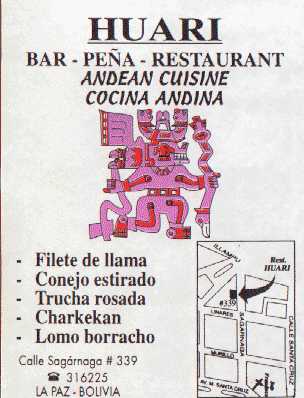 “gringo
trail” but very good.
All the other customers seemed to be gringos - French, US,
Australian. We had llama
kebabs which were quite mild compared to the vicuña.
We were served with far too much food.
The Bolivian folk music was supposed to start at 2100 and was the
main reason we had chosen this restaurant.
We ate very slowly to stay up that late (we were now conditioned
to Putre eating habits) but there was a charge of 15B (just under £2)
and we were the only ones willing to pay.
That was only because when the waiter asked us we didn’t
understand what he was saying and just said “si si”.
The leader of the music group came over to explain and offered us
a drink in recompense. We
could also come and watch free tomorrow (not much use to us as we were
moving on). “gringo
trail” but very good.
All the other customers seemed to be gringos - French, US,
Australian. We had llama
kebabs which were quite mild compared to the vicuña.
We were served with far too much food.
The Bolivian folk music was supposed to start at 2100 and was the
main reason we had chosen this restaurant.
We ate very slowly to stay up that late (we were now conditioned
to Putre eating habits) but there was a charge of 15B (just under £2)
and we were the only ones willing to pay.
That was only because when the waiter asked us we didn’t
understand what he was saying and just said “si si”.
The leader of the music group came over to explain and offered us
a drink in recompense. We
could also come and watch free tomorrow (not much use to us as we were
moving on).
Thursday 9 July
A bus collected us from hotel somewhat later
than 0715. It was full of gringos.
The road to Copacabana was much the same as the road in with mud
and brick buildings spread out over the countryside and everyone seemed
to have a cow, some sheep, a couple of donkeys.
In some of the mountainous bits there were people working down in
the valleys and the dogs sat by the road at the top.
Copacabana had major drain laying in
progress so it was an obstacle course to walk down the main road.
We could see several new modern hotels.
This was Bolivia’s holiday resort but we were not impressed.
Just before Copacabana we had to cross the narrow part of Lake
Titicaca. The passengers
went on a motor launch and the coach on a wooden raft.
There was some confusion as we drove round the lake as we seemed
to be going the wrong way and had the lake on the wrong side of us - I
couldn’t work that one out.
There was no hassle at the Bolivian border,
as the book said there sometimes was, and we then had to walk 30 yards
to the Peruvian side. One chap put the passport details into his computer and the
other stamped the passport.
The stamper asked me if I was going to Peru?
Maybe I misunderstood him or maybe it was a trick question?
It was still another couple of hours around
the lake to Puno.
There was an Israeli couple at the front of the bus who spent the
whole of the journey talking and laughing loudly to the Israeli couple
behind and drove us all potty.
We were glad to get off.
When we arrived the bus driver suggested one hostel, the conductor
another and the rickshaw drivers outside all crowded round offering to
take us somewhere.
Pandemonium. As I could see the name of one of the recommended hostels
from where we were standing Jen and I walked.
Some Australians were there too so we were shown around together.
Hot water was promised.
We went for a walk through the market which
was quieter than La Paz, and then found one pedestrianised street lined
with gringo restaurants.
We were attracted to one serving alpaca and cuy (guinea pig) and
went in to investigate. It
was a very dark bistro like place - so dark it was annoying, you had to
strain to read the menus and there was a US female with an extremely
loud voice in the opposite corner (certain loud voices obviously
irritate me). After a quick
and very good coffee we resolved to find somewhere more Peruvian which
was easily achieved. Having
been surprised that the Chileans were staturally challenged, we were
further surprised by the Peruvians - they were even shorter.
Earlier when we had met the Australians
again outside the hotel they had given us a report on what they’d found
out about the islands on Lake Titicaca, trains to Cusco and laundry -
other gringos are very handy sometimes!
Our nearest travel agent was as good as any so we booked and paid for an
all day trip to Uros and Taquile on Lake Titicaca and the train to Cucso
on Saturday.
Whilst buying fruit on the way home Jen had
quick conversation with one of the market sellers about the trader’s
sons marrying Jen’s daughters.
Unfortunately Jen only has sons.
Friday 10 July
The bus to the harbour left at 0730 although
the harbour appeared to be just around the corner - no sooner had we got
on the bus than we got off and walked to the boat.
The town of Puno is next to a natural cove
at the end of Lake Titicaca and the water was green with algae.
The small motor launch had a diesel motor which needed air as the hatch
was fixed open with a screwdriver fitting into a hole used many times.
Every now and again the vibration would move the screwdriver and
the hatch would slam shut, making us all jump.
The boat was full of gringos - Dutch, Australian, French, English
and others. The first stop
was Huacavacani, the main floating island of Uros.

The tortora reeds were very spongey to tread
on.
We had to walk up a path of women with their wares - small reed
boats and embroidered hangings.
The houses were made of reeds too.
The real reed boats were quite impressive with their animal heads,
vaguely like Viking boats.
There was a tower which Jen climbed to take a picture of the next island
and was asked for money.
The “museum” was a display of stuffed birds, ducks, gulls, even
flamingoes, the local small ones. There are only a few hundred Uros Indians living on the
islands, most are a mixture of the original Uros and the larger Aymara
tribe. They live off
fishing and catching birds and some, we were informed, live in Puno and
just come out to sell things to the tourists.
When the Incas controlled the region, they considered the Uros so
poor - almost subhuman - that the only tribute required of them was a
section of hollow cane filled with lice.
The Seventh Day Adventist missionary school was the only building
of wood. We were somewhat
uneasy with the human zoo like atmosphere.
Another three hours on the water through the
straits and into the lake proper (blue by now) to Taquile.
Taquile has been inhabited for over ten thousand years, with agriculture
being introduced about 4000 BC.
It was dominated by the Aymara speaking Tiahuanuco culture until the
thirteenth century, when the Incas conquered it and introduced the
Quechua language. In 1580, the island was “bought” by Pedro Gonzalez de Taquile
and so came under Spanish influence.
During the 1930s it was used as a safe exile/prison for
troublesome characters like former president Sanchez Cerro, and it
wasn’t until 1937 that the residents - the local descendents of the
original Indians - regained legal ownership by buying it back.
Jen and I had lunch by the harbour before tackling 525 steps to
the top of the island.
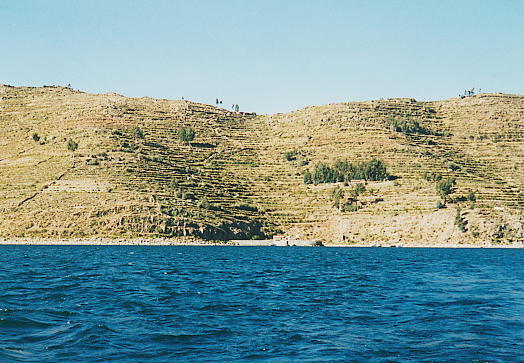
The grey blob in the middle at the bottom is
the harbour and the trees in the middle at the top are at the entrance
to the village.
We were still at 3500m.
There were quite a few people living on Taquile - mainly making
waistcoats, shirts, scarves, hats, etc. and running the many
restaurants.
There were hordes of gringos.
Jen went off to look at the ruins of Uray K’ari, built of stone
in the Tiahuanuco era around 800 AD.
I watched some little girls playing jacks but they were
suspicious of me and stopped the game whispering to each other.
There were large amounts of ancient terracing around the steep
sided island. Such terraces
are extremely important here in the middle of the lake where soil
erosion would otherwise kill the island’s largely self-sufficient
agricultural economy.
Potatoes, corn, broad beans and quinoa are the main crops.
Without good soil, Taquile would become like the main floating
islands, dependant on tourism for its income.
The baños by the harbour at Taquile had the only ancient French
type toilet I had seen so far, in a small and very smelly hut which was
obviously built for short people. It was a long cold trip back.
The two Indian boatmen retreated into the cabin to knit when they
were not needed for nautical duties.
I thought it was a pity we were travelling in a motor boat as, if
it had been a sailing boat, the actual journey would have been more
exciting - there appeared to be plenty of wind.
Saturday 11 July
We had failed to get Executive class tickets
at $21 (£13.50) and had been downgraded to Economy at 25 soles (£6.75).
It looked like a regular BR train.
Almost everyone was a gringo with a backpack which stretched the
luggage racks to the utmost and almost started a fight when latecomers
discovered the racks over their seats were already full.
Two Swiss girls from Bern sat opposite us, Kathrin and Sonia.
Kathrin made handicrafts and Sonia worked in social education.
As well as speaking French, German and Swiss German they also
spoke Spanish (learnt whilst travelling in Central and South America)
and English. It was difficult to control the feelings of inadequacy!
The train’s steward offered us coffee, tea
and coca tea as well as soft drinks.
We were serenaded by a very good panpipe group.
There was a shoeshine boy trying to persuade us to have our clean boots
cleaned and then the local salesmen started in earnest.
Jumpers, shirts, hats, scarves, brass, chocolate, rugs.
In between stations they plied their wares and then got off or
moved to another carriage to be replaced by another lot - bread, cakes,
empanadas (small pastries stuffed with spicy meat or chicken and
vegetables - usually very tasty but sometimes they included boiled egg).
In the end both Jen and I bought jumpers.
We were worn down!
The Americans on the train stuck together whilst we chatted to the
Europeans and Australians. We played cards and Jen won every time! Over the pass at 4200m with amazing mountain views on each
side. We saw thermal
springs and bathers close by the side of the track.
Towards Cusco the hotel touts appeared and
Jen and I chose a cheap one at S20 (£5.40).
It was awful. It had
beds and a private bathroom but was very depressing.
We found somewhere more hospitable, San Blas, that same evening
and arranged to move in there the next day.
Having eaten our way up on the train, we spent the evening in a
local bar watching a Queen video.
Jen is a great fan of Freddie Mercury.
Not a gringo in sight.
The boys on the next table bought us a coca-cola so we could join in
their toasts although we didn’t know what they were toasting!
It was an extremely cold night.
Sunday 12 July
We removed to San Blas as early as possible.
The aged proprietor (San Blas senior) who seemed a bit surly last
night was now all smiles and maybe even had matrimonial intentions
towards Jen. The room was a
lot smaller than the previous night but much brighter.
The hotel was built around a courtyard and was very attractive
and clean.
Later we met San Blas junior who, I thought,
was the real proprietor and no relation to San Blas senior although they
both had a proprietary air.
He spoke a little English but somehow we never managed to ask who
owned the place.
To get to the main square, we had to walk
through Hathunrumiyoc - the most famous Inca passageway of all.
One wall was made of huge blocks fitted together with no cement,
including the famous twelve sided stone, best known due to its
representation on Cusqueña beer bottles and one of Peru’s very best
examples of Inca stonework. Although we saw paintings and postcards of the stone we never
actually found it. The top
half of the wall was plastered and the roof overhung.
The wall was originally part of the palace of Inca Roca (the
sixth emperor).
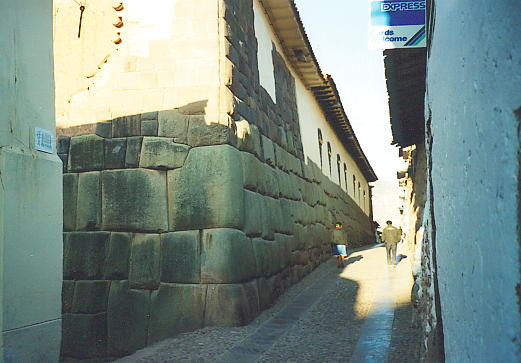
Hathunrumiyoc
At the Plaza de Armes there was a parade of
the Police, the Army, the boys brigade, people with prams, people in
wheelchairs and someone who Jen thought was the President.
We heard lots of marching music, slightly off key, 21 gun salutes, even
singing as the flags went up, the red and white Peruvian one and another
rainbow coloured one. I
thought I could join in because the notebook I had purchased in Puno
contained the words of the Peruvian national anthem but they didn’t
appear to be singing that!
Whilst Jen was not looking someone kindly
walked off with her knapsack. Another
trip to the Police. The map
said one road but it turned out to be somewhere else, the only road I
knew in Cusco, way out on the edge of the city.
I only knew that particular road because I was thinking of
suggesting a hostel there and the name had stuck in my mind.
The contents were not worth anything but did include Jen’s
glasses and all the papers concerning the first burglary as well as the
Youth Hostel book. No Youth
Hostels in Peru for us. We
were not too perturbed although Jen wished she had put the papers in her
big rucksack. She also
couldn’t see to read. (I
hoped I didn't lose my glasses or I would be doing the reading and Jen
would be leading me around.)
We bought some postcards at S3 for 5 (16p each) from one of the little
boys in the square and then realised they were only S1.90 for 4 (13p
each) in the shops! At
least he went off happy. It
is sobering to think that a difference of 3p per card had the power to
make someone happy. We were
approached by our first art student selling what he said were his own
water colours of Cusco.
The square was magnificent with cathedrals
on two sides, shops with large balconies and a covered walkway
underneath on the other two sides, a fountain and flower beds in the
middle.
Then we had to start the round of tourist agencies.
Chris, the English music teacher from Rio we met on Lake
Titicaca, recommended one that had charged him $65 for the three day
Inca Trail all in. We
collected details and prices of trains to Machu Picchu, riding, white
water rafting and jungle trips.
We found a little bread shop that sold empanadas - meat and lentil - and
even warmed them slightly in a microwave.
The Peruanos were not keen on hot food.
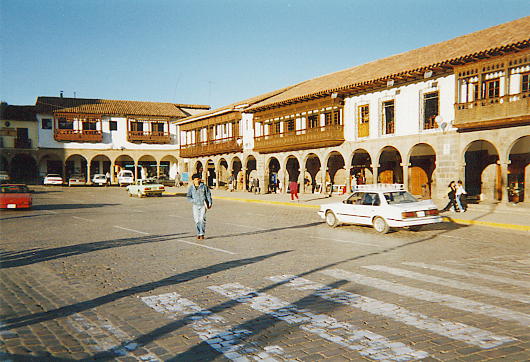
Cusco
There were several pretty little squares in
Cusco often with fountains.
The city was full of artesanal shops and we were tempted by the
shirts and wall hangings but always there was the transportation
problem. By evening we had
planned our programme for the next week and tried to book with Cesar,
one of our first contacts, but he had disappeared so his office had to
do. White water rafting on
Monday for $22 (£13.86) each from 0900 to 1600.
Horse riding for me for $12 (£7.56) on Tuesday from 0900 to 1300.
On Wednesday we planned to catch a local train to Aguas Calientes and
stay the night there. On Thursday we would go to Machu Picchu and back to Cusco on
Friday, $50.75 (£31.97) each.
We left booking the jungle trip until we had ascertained whether our
malaria pills affected us or not.
Dinner was at one of the little places we had spotted earlier - a three
course meal for S3.50 (£0.94) and not a gringo in sight.
Monday 13 July
A minibus collected us at 0900ish and then
did three or four circuits around the town collecting others until
eventually we had to change to a lorry as there were too many people.
The lorry had a name - Erik Adventure.
We drove up the hill out of Cusco, through
many villages and past much agriculture, tilled fields for miles with no
hedges or walls, tethered animals with the occasional escapee on the
road, and then down to the river at Urubamba over an ear popping pass.
At Urubamba we followed the eponymous river
for a while and then pulled up beside the road.
There were two guides, one for each raft and the driver who would meet
us at the other end. The
rafts had to be inflated.
We were all given a helmet, life jacket, pink polo neck top and paddle.
The excitement was building but I didn’t realise we had to work.
We had lessons in paddling and commands on the beach and then it was off
down the river.
We had more lessons in the water and Maurice, our guide and
leader, was very patient.
The two rafts were split English/Spanish and
Jen had to go with the Spanish as she was the only one who admitted to
knowing any of the language.
They were mostly 19 or 20 years old and out for a good time.
We were more mature and took it seriously.
The river was only 2 with 3 spots (grades for rafting) but it was
brilliant fun.
Halfway down the river it was crossed by a
small bridge. Rafts were beached so macho types (and Jen) could climb on
the bridge and jump into the river.
It was a wonderful photo opportunity but I had left the camera at
home (to prevent water damage - last night at San Blas we looked at a
Dutch guy’s pictures of the raft he and his mate made at Pillcopata
until the photos stopped abruptly when his camera drowned).
There was a magnificent view of the snow topped mountain,
Veronica, towering above us.
After two or three hours (I had left my watch at San Blas, water damage
prevention again) we were all soaked and tired but sad that it was all
over. There was a small
grassy place by the river at which all the groups stopped so we left the
river there and had lunch.
The dirt track back took us to Ollantaytambo,
a little village in the Sacred Valley surrounded by Inca ruins, the
fortress of Ollantay. Legend has it that Ollantay was a rebel Inca general who took
arms against Pachacutec over the affections of the Lord Inca’s daughter.
This was the only Inca stronghold ever to have resisted persistent
Spanish attack..
It was very spectacular but we had just 15 minutes so could only
stand and admire. The truck
went back to Urubamba and my eyes would not stay open.
It was warm, well warm and damp, the sun was streaming in the
window and I dozed whilst noticing the pressure change as we went up the
hill. We were back in Cusco
by 1800. It was supposed to
be 1600 but what happened to the other two hours I don’t know.
Tuesday 14 July
Two women arrived to collect me just as San
Blas junior was ringing to see where they were.
We walked down the road and then they hailed a taxi which took us up the
hill out of Cusco to Saqsayhuaman (this must be a joke, it is pronounced
sexy woman). There I had to buy a tourist ticket - they didn’t tell me
that at the Tourist Office.
Fortunately I had S20 on me and a ticket for the four sites I would be
visiting was S16.50 (£4.46).
Saqsayhuaman was started in the 1440s but it
took nearly a century to complete.
It has been estimated that some twenty thousand men were involved
in its construction; four thousand cutting blocks from quarries, six
thousand dragging them on rollers to the site; and another ten thousand
working on finishing and fitting them into position.
With only natural fibre ropes, stone hammers and bronze chisels
it must have been an enormous task.
Protected by such a steep approach from the town, the fortress
only needed defensive walls on one side.
The three massive, parallel walls zigzag together for some 600m.
There’s not much of the inner fortress left
but the enormous ramparts still stand 20m high, quite unperturbed by
past battles, earthquakes and the passage of time.
The strength of the massive, mortarless stonework - one block weighs
more than 300 tonnes - is matched by the brilliance of its design; the
zigzags, casting shadows in the afternoon sun, not only look like jagged
cat’s teeth, but also expose the flanks of any attackers trying to
clamber up.
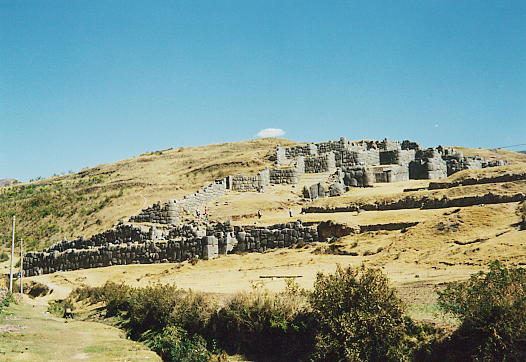
Saqsayhuaman
We walked past Saqsayhuaman - not much of a
visit! - and arrived at the ranch.
There were lines of horses with Western type saddles who just stayed
where they were put. I was assigned to one of Mario’s. A pony called Negra who was ridden with rope reins from an
integral rope head collar.
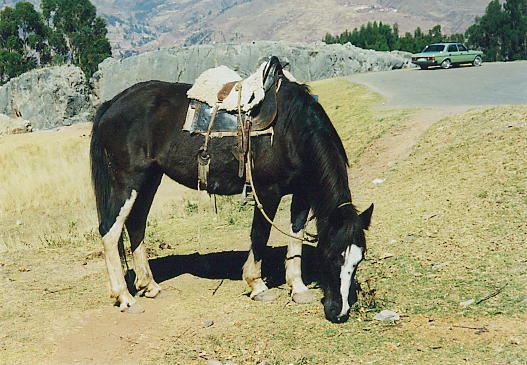
Mario and I set off at a lick up the hill to
Qenko - little passages through and caves in the rocks for the mummies.
My saddle had a bit of old llama thrown over it and was very
comfortable. The trip was
mainly at sitting trot with Mario whacking Negra from behind!
We even had a little buck and a canter.
Mario spoke a little English and was particularly happy because
his wife had just had a baby boy, their first child.
The next stop, the Temple of the Moon, was
protected by stone images of the snake, puma (headless) and condor.
Inside there were representations of the three and the moon. Further inside, a hole to the roof of the cave and a large
round slab of rock underneath.
When the moon was full its light covered the rock.
There was good energy here and Mario explained you could see it
if you tried really hard!
There was more riding along dust paths, the
horse was so surefooted I didn’t mind being on the edge of a drop but
she did like walking on the road if possible and I had to persuade her
back on the track in case we were run over.
The traffic did give us a wide berth though - more than they do in
England sometimes!
Tambomachay was the women’s area - baños
with underground water emerging from a hole at the base of the
stonework, creating a cold shower just about high enough for an Inca to
stand under.
Puka Pukara, the “Red Fort”, was where the men hung out and could
well have been more a hunting lodge than a defensive position.
Negra knew the way home.
At Saqsayhuaman I left Mario and his lovely ponies to walk into Cusco.
On the way back to San Blas, I peered
through a doorway and spotted tables and chairs in a courtyard in the
sunshine.
Lunch! It turned out
this was part of the Hotel Monasterio in which I was met by Ruben and
given the guided tour. It
was an old monastery converted to a hotel with 200 odd rooms and inner
courtyards full of grass, flowers and fountains.
Ruben could not have been more helpful.
Some of the cloisters had been glassed in and there was some poor
girl going round cleaning them - it looked like a full time job.
Lunch was expensive at S26.00 (£7.03)
compared to our normal meal although not by English standards but what
do you expect with zillions of waiters, beautifully presented, waiting
on you hand and foot.
Both Ruben and Luis practised their English on me.
Luis was the third person that day to ask if I was going dancing
that night? He was off to
the festival at Pisac on his day off the next day.
Ruben finished at two and offered to escort me around the town in
order to practise his English, so he said!
I let him use my camera!
Chapter 4
Top of page
Home |